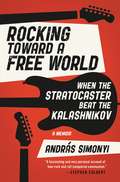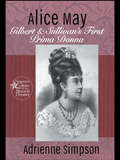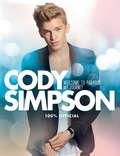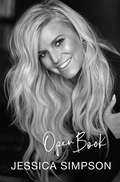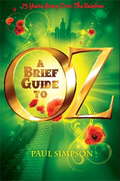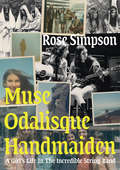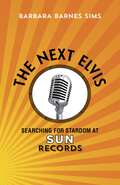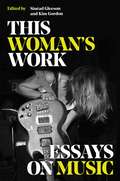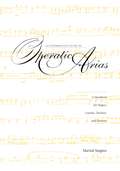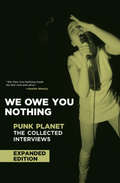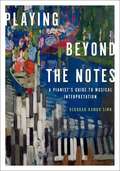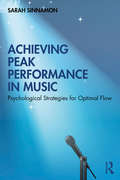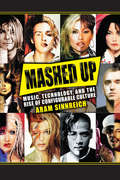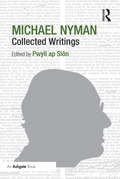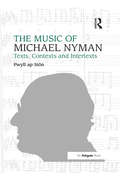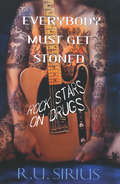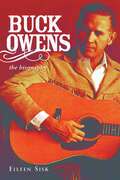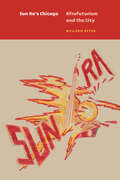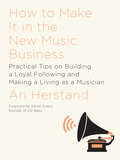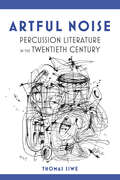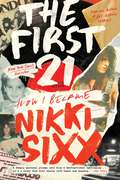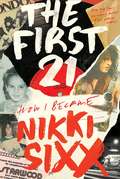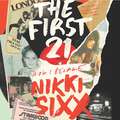- Table View
- List View
Rocking Toward a Free World: When the Stratocaster Beat the Kalashnikov
by András SimonyiFrom renowned diplomat and musician András Simonyi -- whom Stephen Colbert calls "the only ambassador I know who can shred a mean guitar!" -- comes a timely and revealing memoir about growing up behind the Iron Curtain and longing for freedom while chasing the great power of rock and roll. p.p1 {margin: 0.0px 0.0px 0.0px 0.0px; text-indent: 36.0px; font: 12.0px Arial} In ROCKING TOWARD A FREE WORLD, Simonyi charts the struggle of growing up in 1960s Hungary, a world in which listening to his favorite music was a powerful but furtive endeavor: records were black-market bootlegs; concerts were held under strict control, even banned; protests were folded into song lyrics. Get caught listening to Western radio could mean punishment, maybe prison. That didn't matter to Simonyi, who from an early age felt the tremendous pull of rock and roll, the lure of American popular culture, and a burning desire to buck the system. Inspired by the protest music coming out of the West, he formed a band and became part of Hungary's burgeoning rock scene. Then came the setbacks: tightening of control by the state, the seemingly inescapable weight of an authoritarian system, and the collapse of Simonyi's own dreams of stardom. A story of youth, rebellion, and hope, ROCKING TOWARD A FREE WORLD sheds new light on two of the most powerful forces of the modern age: global democracy and rock and roll. Deeply vital and compelling, Simonyi's memoir chronicles how one man's tremendous connection to American and British popular music inspired him to make a difference in his country and, eventually, the world. It tells the story of a generation, as played out in song lyrics and guitar riffs. p.p1 {margin: 0.0px 0.0px 0.0px 0.0px; font: 13.0px Times} p.p2 {margin: 0.0px 0.0px 0.0px 0.0px; font: 13.0px Times; min-height: 16.0px}
Alice May: Gilbert & Sullivan's First Prima Donna (Forgotten Stars of the Musical Theatre)
by Adrienne SimpsonThis biography tells the story of Alice May, a touring prima donna in the nineteenth century who travelled from England to Australia, New Zealand, India and the US, taking part in pioneering performances of the popular light operas of the day. Along the way she took part in many premieres, including the first production of Gilbert and Sullivan's The Sorcerer and the first authorised American production of The Mikado . This colourful life story will appeal to theatre historians, fans of the melodrama, burlesque, and the musical stage.
Cody Simpson: My Journey
by Cody SimpsonThe first official all-access look into the life of singing sensation Cody Simpson. Follow Cody as he goes from singing cover songs in his bedroom to opening sold-out concerts for Justin Bieber. With never-before-seen photos, behind-the-scenes interviews, and exclusive information, this book is perfect for pop music fans and for Codys Angels.
Open Book
by Jessica SimpsonThe #1 New York Times BestsellerJessica reveals for the first time her inner monologue and most intimate struggles. Guided by the journals she's kept since age fifteen, and brimming with her unique humor and down-to-earth humanity, Open Book is as inspiring as it is entertaining.This was supposed to be a very different book. Five years ago, Jessica Simpson was approached to write a motivational guide to living your best life. She walked away from the offer, and nobody understood why. The truth is that she didn’t want to lie.Jessica couldn’t be authentic with her readers if she wasn’t fully honest with herself first.Now America’s Sweetheart, preacher’s daughter, pop phenomenon, reality tv pioneer, and the billion-dollar fashion mogul invites readers on a remarkable journey, examining a life that blessed her with the compassion to help others, but also burdened her with an almost crippling need to please. Open Book is Jessica Simpson using her voice, heart, soul, and humor to share things she’s never shared before.First celebrated for her voice, she became one of the most talked-about women in the world, whether for music and fashion, her relationship struggles, or as a walking blonde joke. But now, instead of being talked about, Jessica is doing the talking. Her book shares the wisdom and inspirations she’s learned and shows the real woman behind all the pop-culture cliché’s — “chicken or fish,” “Daisy Duke,” "football jinx," “mom jeans,” “sexual napalm…” and more. Open Book is an opportunity to laugh and cry with a close friend, one that will inspire you to live your best, most authentic life, now that she is finally living hers.
A Brief Guide To OZ: 75 Years Going Over The Rainbow (Brief Histories)
by Paul SimpsonWhat if Dorothy Gale wasn't the only person who went to see the Wizard of Oz? MGM's landmark 1939 movie The Wizard of Oz, starring Judy Garland, did not mark the beginning of adventures in Oz. Both before and since, dozens of tales have been told of the Marvellous Land of Oz, and its inhabitants such as the Scarecrow, the Tin Woodman, the Cowardly Lion, the Hungry Tiger and Jack Pumpkinhead. In this fascinating and wide-ranging book, Paul Simpson looks back at the Famous Forty - the original novels by L. Frank Baum and his successors which entranced generations of children with their wonderful world of munchkins, princesses and wicked witches. He examines the many ways in which the stories have been retold in movies - from the silent era to Disney's recent blockbuster Oz the Great and Powerful - and on television, featuring everyone from Tom & Jerry to trades union leaders. On stage, Oz has come to life in the many revivals of The Wizard of Oz musical and the worldwide reign of Elphaba in the smash hit Wicked. Celebrate the 75th anniversary of the world's best-loved film and the whole magical world of Oz with its vampires, muppets, dragons, living statues and so much more.
Muse, Odalisque, Handmaiden: A Girl’s Life in the Incredible String Band
by Rose SimpsonA memoir by a member of the Incredible String Band that charts a journey from hippie utopia to post-Woodstock implosion.Between 1967 and 1971 Rose Simpson lived with the Incredible String Band (Mike Heron, Robin Williamson and Licorice McKechnie), morphing from English student to West Coast hippie and, finally, bassist in leathers. The band's image adorned psychedelic posters and its music was the theme song for an alternative lifestyle. Rose and partner Mike Heron believed in, and lived, a naive vision of utopia in Scotland. But they were also a band on tour, enjoying the thrills of that life. They were at the center of "Swinging London" and at the Chelsea Hotel with Andy Warhol's superstars. They shared stages with rock idols and played at Woodstock in 1969. Rose and fellow ISB member Licorice were hippie pin-ups, while Heron and Robin Williamson the seers and prophets of a new world.
The Next Elvis: Searching for Stardom at Sun Records
by Barbara Barnes SimsAn American institution, Sun Records has a history with many chapters -- its Memphis origins with visionary Sam Phillips, the breakthrough recordings of Elvis Presley, and the studio's immense influence on the sound of popular music. But behind the company's chart toppers and legendary musicians there exists another story, told by Barbara Barnes Sims. In the male-dominated workforce of the 1950s, 24-year-old Sims found herself thriving in the demanding roles of publicist and sales promotion coordinator at Sun Records. Sims's job placed her in the studio with Johnny Cash, Roy Orbison, Jerry Lee Lewis, Charlie Rich, Carl Perkins, and other Sun entertainers, as well as the unforgettable Phillips, whose work made the music that defined an era.The Next Elvis: Searching for Stardom at Sun Records chronicles Sims's career at the studio, a pivotal time at this recording mecca, as she darted from disc jockeys to distributors. Sims not only entertains with personal stories of big personalities, but also brings humor to the challenges of a young woman working in a fast and tough industry.Her disarming narrative ranges from descriptions of a disgraced Jerry Lee Lewis to the remarkable impact and tragic fall of DJ Daddy-O Dewey to the frenzied Memphis homecoming of Elvis after his military service. Collectively, these vignettes offer a rare and intimate look at the people, the city, and the studio that permanently shifted the trajectory of rock 'n' roll.
This Woman's Work: Essays on Music
by Sinéad Gleeson and Kim GordonEdited by iconic musician Kim Gordon and esteemed writer Sinéad Gleeson, this powerful collection of award-winning female creators shares their writing about the female artists that matter most to them. This book is for and about the women who kicked in doors, as pioneers of their craft or making politics central to their sound: those who offer a new way of thinking about the vast spectrum of women in music.This Woman&’s Work: Essays on Music is edited by iconic musician Kim Gordon and esteemed writer Sinéad Gleeson and features an array of talented contributors, including: Anne Enright, Fatima Bhutto, Jenn Pelly, Rachel Kushner, Juliana Huxtable, Leslie Jamison, Liz Pelly, Maggie Nelson, Margo Jefferson, Megan Jasper, Ottessa Moshfegh, Simone White, Yiyun Li, and Zakia Sewell.In this radical departure from the historic narrative of music and music writing being written by men, for men, This Woman&’s Work challenges the male dominance and sexism that have been hard-coded in the canons of music, literature, and film and has forced women to fight pigeon-holing or being side-lined by carving out their own space. Women have to speak up, to shout louder to tell their story—like the auteurs and ground-breakers featured in this collection, including: Anne Enright on Laurie Anderson; Megan Jasper on her ground-breaking work with Sub Pop; Margo Jefferson on Bud Powell and Ella Fitzgerald; and Fatima Bhutto on music and dictatorship.This Woman&’s Work also features writing on the experimentalists, women who blended music and activism, the genre-breakers, the vocal auteurs; stories of lost homelands and friends; of propaganda and dictatorships, the women of folk and country, the racialized tropes of jazz, the music of Trap and Carriacou; of mixtapes and violin lessons.
An Interpretive Guide to Operatic Arias: A Handbook for Singers, Coaches, Teachers, and Students
by Martial SingherA premier singer and master teacher here tells other singers how to get the most from 151 famous arias selected for their popularity or their greatness from 66 operas, ranging in time and style from Christopher Gluck to Carlisle Floyd, from Mozart to Menotti. “The most memorable thrills in an opera singer's life,” according to the author's Introduction, “may easily derive from the great arias in his or her repertoire.”This book continues the work Martial Singher has done, in performances, in concerts, and in master classes and lessons, by drawing attention “not only to precise features of text, notes, and markings but also to psychological motivations and emotional impulses, to laughter and tears, to technical skills, to strokes of genius, and even here and there to variations from the original works that have proved to be fortunate.”For each aria, the author gives the dramatic and musical context, advice about interpretation, and the lyric—with the original language (if it is not English) and an idiomatic American English translation, in parallel columns. The major operatic traditions—French, German, Italian, Russian, and American—are represented, as are the major voice types—soprano, mezzo-soprano, tenor, baritone, bass-baritone, and bass.The dramatic context is not a mere summary of the plot but is a penetrating and often witty personality sketch of an operatic character in the midst of a situation. The musical context is presented with the dramatic situation in a cleverly integrated way. Suggestions about interpretation, often illustrated with musical notation and phonetic symbols, are interspersed among the author's explication of the music and the action. An overview of Martial Singher’s approach—based on fifty years of experience on stage in a hundred roles and in class at four leading conservatories—is presented in his Introduction. As the reader approaches each opera discussed in this book, he or she experiences the feeling of participation in a rehearsal on stage under an urbane though demanding coach and director.The Interpretive Guide will be of value to professional singers as a source of reference or renewed inspiration and a memory refresher, to coaches for checking and broadening personal impressions, to young singers and students for learning, to teachers who have enjoyed less than a half century of experience, and to opera broadcast listeners and telecast viewers who want to understand what goes into the sounds and sights that delight them.
An Interpretive Guide to Operatic Arias: A Handbook for Singers, Coaches, Teachers, and Students
by Martial SingherA premier singer and master teacher here tells other singers how to get the most from 151 famous arias selected for their popularity or their greatness from 66 operas, ranging in time and style from Christopher Gluck to Carlisle Floyd, from Mozart to Menotti. “The most memorable thrills in an opera singer's life,” according to the author's Introduction, “may easily derive from the great arias in his or her repertoire.”This book continues the work Martial Singher has done, in performances, in concerts, and in master classes and lessons, by drawing attention “not only to precise features of text, notes, and markings but also to psychological motivations and emotional impulses, to laughter and tears, to technical skills, to strokes of genius, and even here and there to variations from the original works that have proved to be fortunate.”For each aria, the author gives the dramatic and musical context, advice about interpretation, and the lyric—with the original language (if it is not English) and an idiomatic American English translation, in parallel columns. The major operatic traditions—French, German, Italian, Russian, and American—are represented, as are the major voice types—soprano, mezzo-soprano, tenor, baritone, bass-baritone, and bass.The dramatic context is not a mere summary of the plot but is a penetrating and often witty personality sketch of an operatic character in the midst of a situation. The musical context is presented with the dramatic situation in a cleverly integrated way. Suggestions about interpretation, often illustrated with musical notation and phonetic symbols, are interspersed among the author's explication of the music and the action. An overview of Martial Singher’s approach—based on fifty years of experience on stage in a hundred roles and in class at four leading conservatories—is presented in his Introduction. As the reader approaches each opera discussed in this book, he or she experiences the feeling of participation in a rehearsal on stage under an urbane though demanding coach and director.The Interpretive Guide will be of value to professional singers as a source of reference or renewed inspiration and a memory refresher, to coaches for checking and broadening personal impressions, to young singers and students for learning, to teachers who have enjoyed less than a half century of experience, and to opera broadcast listeners and telecast viewers who want to understand what goes into the sounds and sights that delight them.
We Owe You Nothing: Expanded Edition (Punk Planet Bks.)
by Daniel SinkerUpdated with six more interviews and a new introduction, the expanded edition of We Owe You Nothing brings the definitive book of conversations with the underground's greatest minds up to 2007. New interviews include talks with bands like The Gossip and Maritime, a conversation with punk legend Bob Mould, and more . . . in addition to the classic interviews from the original 2001 edition: Ian MacKaye, Jello Biafra, Thurston Moore, Noam Chomsky, Kathleen Hanna, Black Flag, Sleater-Kinney, Steve Albini, Frank Kozik, Art Chantry, and others. Daniel Sinker has been the editor and publisher of Punk Planet magazine for twelve years.
Playing Beyond The Notes: A Pianist's Guide to Musical Interpretation
by Deborah Rambo SinnThis book demystifies the complex topic of musical interpretation by boiling it down to basic principles in an accessible writing style. The book targets pianists, piano teachers, and piano pedagogy students and incorporates over 200 musical examples from the intermediate and advanced piano repertoire.
Achieving Peak Performance in Music: Psychological Strategies for Optimal Flow
by Sarah SinnamonAchieving Peak Performance in Music: Psychological Strategies for Optimal Flow is a unique and comprehensive exploration of flow in music performance. It describes the optimal performance experiences of great musicians and outlines ten psychological steps that can be implemented to facilitate and enhance optimal experience. Achieving Peak Performance in Music reveals strategies used by experts to prepare themselves emotionally, cognitively, and physically for performance. Combining this information with research carried out amongst professional performers and knowledge gained from decades of study and research by psychologists on how to achieve a positive experience, the book guides readers on a pathway towards optimal performance. Using everyday language, it presents invaluable practical guidance and a toolbox of strategies to help with all aspects of performance, including memorisation, visualisation, focus, performance anxiety, thought management, motivation, and pre-performance routines. Based on psychological research, the book shares practical knowledge invaluable to music students, parents, and amateur and professional musicians. The strategies on performance provided are applicable to every type of performance, from a student exam to a gig or a concert, making Achieving Peak Performance in Music a significant resource for anyone looking to achieve peak performance.
Mashed Up: Music, Technology, and the Rise of Configurable Culture
by Aram SinnreichFrom ancient times to the present day, writers and thinkers have remarked on the unique power of music to evoke emotions, signal identity, and bond or divide entire societies, all without the benefit of literal representation. Even if we can't say precisely what our favorite melody means, we know very well what kind of effect it has on us, and on our friends and neighbors. According to Aram Sinnreich, this power helps to explain why music has so often been regulated in societies around the globe and throughout history. Institutional authorities ranging from dynastic China's "Office to Harmonize Sounds" to today's copyright collecting societies like BMI and ASCAP leverage the rule of law and the power of the market to make sure that some musical forms and practices are allowed and others are prohibited. Yet, despite the efforts of these powerful regulators, musical cultures consistently devise new and innovative ways to work around institutional regulations. These workarounds often generate new styles and traditions in turn, with effects far beyond the cultural sphere. Mashed Up chronicles the rise of "configurability," an emerging musical and cultural moment rooted in today's global, networked communications infrastructure. Based on interviews with dozens of prominent DJs, attorneys, and music industry executives, the book argues that today's battles over sampling, file sharing, and the marketability of new styles such as "mash-ups" and "techno" presage social change on a far broader scale. Specifically, the book suggests the emergence of a new ethic of configurable collectivism; an economic reunion of labor; a renegotiation of the line between public and private; a shift from linear to recursive logic; and a new "DJ consciousness," in which the margins are becoming the new mainstream. Whether these changes are sudden or gradual, violent or peaceful, will depend on whether we heed the lessons of configurability, or continue to police and punish the growing ranks of the mashed up.
Michael Nyman: Collected Writings
by Pwyll ap SiônFor over three decades Michael Nyman's music has succeeded in reaching beyond the small community of contemporary music aficionados to a much wider range of listeners. An important element in unlocking the key to Nyman's success lies in his writings about music, which preoccupied him for over a decade from the late 1960s to the early 1980s. During this time Nyman produced over 100 articles, covering almost every conceivable musical style and genre - from the Early Music revival and the West's interest in 'world' music, or from John Cage and minimalism to rock and pop. Nyman initiated a number of landmark moments in the course of late twentieth-century music along the way: he was one of the first to critique the distinction between the European avant-garde and the American experimental movement; he was the first to coin the term 'minimalism' in relation to the music of (then largely unknown) Steve Reich and Terry Riley, and later Philip Glass; the first to seriously engage with the music of the English experimental tradition and the importance of Cornelius Cardew, and to identify the importance of Art Colleges in nurturing and developing a radical alternative to modernism; and one of the first writers to grasp the significance of post-minimalists such as Brian Eno and Harold Budd, and to realize how these elements could be brought together into a new aesthetic vision for his own creative endeavours, which was formulated during the late 1970s and early 80s. Much of what transformed and defined Nyman's musical character may be found within the pages of this volume of his writings, comprehensively edited and annotated for the first time, and including previously unpublished material from Nyman's second interview with Steve Reich in 1976. There is also much here to engage the minds of those who are interested in pre-twentieth century music, from Early and Baroque music (Handel and Purcell in particular) to innovative features in Haydn, spatial elements in Berlioz, or Bruckner and Mahler's symphonic works.
The Music of Michael Nyman: Texts, Contexts and Intertexts
by Pwyll ap SiônNyman's rise to international prominence during the last three decades has made him one of the world's most successful living composers. His music has nevertheless been criticized for its parasitic borrowing of other composers' ideas and for its relentless self-borrowing. In this first book-length study in English, Pwyll ap Si laces Nyman's writings within the general context of Anglo-American experimentalism, minimalism and post-minimalism, and provides a series of useful contexts from which controversial aspects of Nyman's musical language can be more clearly understood and appreciated. Drawing upon terms informed by intertextual theory in general, appropriation and borrowing are first introduced within the context of twentieth-century art music and theory. Intertextual concepts are explained and their terms defined before Nyman's musical language is considered in relation to a series of intertextual classifications and types. These types then form the basis of a more in-depth study of his works during the second half of the book, ranging from opera and chamber music to film. Rather than restricting style and technique, Nyman's intertextual approach, on the contrary, is shown to provide his music with an almost infinite amount of variety, flexibility and diversity, and this has been used to illustrate a wide range of technical, aesthetic and expressive forms. He composes with his ear towards the past as if it were a rich quarry to mine, working like a musical archaeologist, uncovering artefacts and chiselling fresh and vibrant sonic edifices out of them.
Everybody Must Get Stoned: Rock Stars On Drugs
by R. U. SiriusKeith's on guitar, Charlie's on drums, and Ronnie's on rhythm. But who's on drugs? Everybody.Welcome to the red-eyed world of rock and roll, where every riff comes with a spliff--a coked-up compendium of your favorite musicians and their favorite drugs. Loaded with sordid tales of debauchery, lists, and bleary-eyed photos, there's more stuff in here than in one of Snoop Dogg's favorite brownies, including: * The Top Ten Albums to Tweak to * The Top Ten Rock Star Drug Quotes * The Top Ten Drug Busts in Rock * Extreme acid casualties * Outrageous drug stories of rock legends * The secret history of Dylan and drugs * Henry Rollins and Frank Zappa: How to act like you're on drugs without actually doing any * And the answer to the ever popular rock and roll drug question, "Who gave the Beatles their first hits of acid?" (Their dentist!)So put on your favorite CD, don't try the green acid, and enjoy! Note: Pages are not suitable for rolling papers. R. U. Sirius (aka Ken Goffman) is the co-editor of 10 Zen Monkeys and the host of two weekly podcasts, "The R.U. Sirius Show" and "Neo-Files with R. U. Sirius." He has worked as a columnist for ArtForum International and The San Francisco Examiner. He has written for Time, Esquire, Wired, and Boing Boing. He is the author of CounterCulture Through the Ages: From Abraham to Acid House, How to Mutate and Take Over the World, and The CyberPunk Handbook, and co-author of Design for Dying with Timothy Leary. He lives in Mill Valley, California.
Buck Owens: The Biography
by Eileen SiskRetracing the life of Buck Owens--from his poverty-stricken youth as the son of a sharecropper to one of the nation's best-loved and wealthiest entertainers--this biography pays tribute to the man and his music by revealing his genius, his warmth, his humor, his vulnerabilities, and his flaws. It is based on personal sources, including original and latter-day Buckaroos, the cohost and the producer of Hee Haw, the former president of Capitol Nashville, and numerous country singers, relatives, ex-wives, ex-lovers, and ex-employees. The result is a 360-degree profile of a shrewd businessman--the polar opposite of the aw-shucks image he cultivated on Hee Haw. Owens was the top-selling country act of the 1960s--with 21 number-one hits and 35 consecutive top-10 hits from 1962 to 1972, a total surpassed only by the Beatles. One of his major contributions to this era was his invention of the Bakersfield sound, mixing electric guitars with a rock 'n' roll beat, which became popular with country and rock fans alike. This biography details the rift Buck had with the Nashville establishment, his reasons for never becoming a member of the Grand Ole Opry, the number of times Buck married, the truth about Buck posing in the nude for Playgirl, and his strained but professional relationship with Hee Haw cohost Roy Clark.
Sun Ra's Chicago: Afrofuturism and the City (Historical Studies of Urban America)
by William SitesSun Ra (1914–93) was one of the most wildly prolific and unfailingly eccentric figures in the history of music. Renowned for extravagant performances in which his Arkestra appeared in neo-Egyptian garb, the keyboardist and bandleader also espoused an interstellar cosmology that claimed the planet Saturn as his true home. In Sun Ra’s Chicago, William Sites brings this visionary musician back to earth—specifically to the city’s South Side, where from 1946 to 1961 he lived and relaunched his career. The postwar South Side was a hotbed of unorthodox religious and cultural activism: Afrocentric philosophies flourished, storefront prophets sold “dream-book bibles,” and Elijah Muhammad was building the Nation of Islam. It was also an unruly musical crossroads where the man then known as Sonny Blount drew from an array of intellectual and musical sources—from radical nationalism, revisionist Christianity, and science fiction to jazz, blues, Latin dance music, and pop exotica—to construct a philosophy and performance style that imagined a new identity and future for African Americans. Sun Ra’s Chicago shows that late twentieth-century Afrofuturism emerged from a deep, utopian engagement with the city—and that by excavating the postwar black experience of Sun Ra’s South Side milieu, we can come to see the possibilities of urban life in new ways.
Liszt
by Sacheverell SitwellBiography of the famous composer, a man of extraordinary magnetism and a pianist of unsurpassed virtuosity. Bibliography and a catalog of Liszt's works included.
How To Make It in the New Music Business: Practical Tips On Building A Loyal Following And Making A Living As A Musician
by Derek Sivers Ari Herstand"Ari is at the front of the front. He gets it. I've read a hundred how-to-make-it-in-the-music-biz books, and this one is today's definitive, comprehensive manual." —Jack Conte, 150+ million YouTube views, Pomplamoose, CEO of Patreon Forget everything you think you know about the odds of “making it” in the music industry. Today, odds mean nothing and success is not about lucky breaks. It’s about conquering social media, mastering the art of merchandising and simply working harder and being smarter than everyone else. We are living in the midst of an industry renaissance, one that has left the record companies desperately struggling to maintain their prominence, as a subculture of dedicated, DIY (do-it-yourself) musicians have taken over. These days talent is a given and success has to be earned. In 2008, Ari Herstand boldly turned in his green Starbucks apron to his manager, determined to make a living off his craft as a singer/songwriter. Almost a decade later, he has become a founding member of the new DIY movement and a self-sustaining musician, all without the help of a major label. Now, drawing from years of experience, Herstand has written the definitive guide for other like-minded artists, the ones who want to forge their own path and not follow the traditional markers of success, like record sales, hits on the radio or the amount of your label advance. Incredibly comprehensive and brutally honest throughout, How to Make It in the New Music Business covers every facet of the "new" business, including how to: Build a grass-roots fan base—and understand the modern fan Book a profitable tour, and tips for playing live, such as opening vs. headlining etiquette, and putting on a memorable show Become popular on YouTube, Spotify and SoundCloud Get songs placed in film and television Earn royalties you didn’t know existed and reach your crowdfunding goals Musicians will not only be introduced to all the tools available today but will be shown how to effectively leverage them to actually make money. More important, they will develop the mindset to be aware of new advancements both online and in the real world and always stay in tune with a constantly evolving landscape. There has never been a better time to be an independent musician. Today, fans can communicate with their idols by simply picking up their phones, artists are able to produce studio-worthy content from their basement and albums are funded not by "record men" but by generous, engaged supporters. As result, How to Make It in the New Music Business is a must-have guide for anyone hoping to navigate the increasingly complex yet advantageous landscape that is the modern music industry.
Artful Noise: Percussion Literature in the Twentieth Century (Music in American Life #502)
by Thomas SiweTwentieth-century composers created thousands of original works for solo percussion and percussion ensemble. Concise and ideal for the classroom, Artful Noise offers an essential and much-needed survey of this unique literature. Percussionist Thomas Siwe organizes and analyzes the groundbreaking musical literature that arose during the twentieth century. Focusing on innovations in style and the evolution of the percussion ensemble, Siwe offers a historical overview that connects the music to scoring techniques, new instrumentation and evolving technologies as well as world events. Discussions of representative pieces by seminal composers examines the resources a work requires, its construction, and how it relates to other styles that developed during the same period. In addition, Siwe details the form and purpose of many of the compositions while providing background information on noteworthy artists. Each chapter is supported with musical examples and concludes with a short list of related works specifically designed to steer musicians and instructors alike toward profitable explorations of composers, styles, and eras.
The First 21: How I Became Nikki Sixx
by Nikki SixxRock-and-roll icon and three-time bestselling author Nikki Sixx tells his origin story: how Frank Feranna became Nikki Sixx, chronicling his fascinating journey from irrepressible Idaho farmboy to the man who formed the revolutionary rock group Mötley Crüe. <P><P> Nikki Sixx is one of the most respected, recognizable, and entrepreneurial icons in the music industry. As the founder of Mötley Crüe, who is now in his twenty-first year of sobriety, Sixx is incredibly passionate about his craft and wonderfully open about his life in rock and roll, and as a person of the world. Born Franklin Carlton Feranna on December 11, 1958, young Frankie was abandoned by his father and partly raised by his mother, a woman who was ahead of her time but deeply troubled. Frankie ended up living with his grandparents, bouncing from farm to farm and state to state. He was an all-American kid—hunting, fishing, chasing girls, and playing football—but underneath it all, there was a burning desire for more, and that more was music. He eventually took a Greyhound bound for Hollywood. <P><P> In Los Angeles, Frank lived with his aunt and his uncle—the president of Capitol Records—for a short time. But there was no easy path to the top. He was soon on his own. There were dead-end jobs: dipping circuit boards, clerking at liquor and record stores, selling used light bulbs, and hustling to survive. But at night, Frank honed his craft, joining Sister, a band formed by fellow hard-rock veteran Blackie Lawless, and formed a group of his own: London, the precursor of Mötley Crüe. <P><P> Turning down an offer to join Randy Rhoads’s band, Frank changed his name to Nikki London, Nikki Nine, and, finally, Nikki Sixx. Like Huck Finn with a stolen guitar, he had a vision: a group that combined punk, glam, and hard rock into the biggest, most theatrical and irresistible package the world had ever seen. With hard work, passion, and some luck, the vision manifested in reality—and this is a profound true story finding identity, of how Frank Feranna became Nikki Sixx. It's also a road map to the ways you can overcome anything, and achieve all of your goals, if only you put your mind to it. <P><P><b>A New York Times Best Seller</b>
The First 21: The New York Times Bestseller
by Nikki SixxNikki Sixx is one of the most respected, recognizable, and entrepreneurial icons in the music industry. As the founder of Mötley Crüe who is now in his twenty-first year of sobriety, Sixx is incredibly passionate about his craft and wonderfully open about his life in rock and roll, and as a person of the world.Born Franklin Carlton Feranna on December 11, 1958, young Frankie was abandoned by his father and partly raised by his mother, a woman who was ahead of her time in some ways and deeply troubled in others. Frankie ended up living with his grandparents, bouncing from farm to farm and state to state. He was an all-American kid-hunting, fishing, chasing girls, and playing football-but underneath it all, there was a burning desire for more, and that more was music. He eventually took a Greyhound bound for Hollywood.In Los Angeles, Frank lived with his aunt and his uncle-the president of Capitol Records. But there was no short path to the top. He was soon on his own. There were dead-end jobs: dipping circuit boards, clerking at liquor and record stores, selling used light bulbs, and hustling to survive. But at night, Frank honed his craft, joining Sister, a band formed by fellow hard-rock veteran Blackie Lawless, and formed a group of his own: London, the precursor of Mötley Crüe. Turning down an offer to join Randy Rhoads' band, Frank changed his name to Nikki London, Nikki Nine, and, finally, Nikki Sixx. Like Huck Finn with a stolen guitar, he had a vision: a group that combined punk, glam, and hard rock into the biggest, most theatrical and irresistible package the world had ever seen. With hard work, passion, and some luck, the vision manifested in reality - and this is a profound true story finding identity, of how Frank Feranna became Nikki Sixx. And it's a road map to the ways you can overcome anything, and achieve all of your goals, if only you put your mind to it.
The First 21: The New York Times Bestseller
by Nikki SixxThe New York Times bestsellerNikki Sixx is one of the most respected, recognizable, and entrepreneurial icons in the music industry. As the founder of Mötley Crüe who is now in his twenty-first year of sobriety, Sixx is incredibly passionate about his craft and wonderfully open about his life in rock and roll, and as a person of the world.Born Franklin Carlton Feranna on December 11, 1958, young Frankie was abandoned by his father and partly raised by his mother, a woman who was ahead of her time in some ways and deeply troubled in others. Frankie ended up living with his grandparents, bouncing from farm to farm and state to state. He was an all-American kid-hunting, fishing, chasing girls, and playing football-but underneath it all, there was a burning desire for more, and that more was music. He eventually took a Greyhound bound for Hollywood.In Los Angeles, Frank lived with his aunt and his uncle-the president of Capitol Records. But there was no short path to the top. He was soon on his own. There were dead-end jobs: dipping circuit boards, clerking at liquor and record stores, selling used light bulbs, and hustling to survive. But at night, Frank honed his craft, joining Sister, a band formed by fellow hard-rock veteran Blackie Lawless, and formed a group of his own: London, the precursor of Mötley Crüe. Turning down an offer to join Randy Rhoads' band, Frank changed his name to Nikki London, Nikki Nine, and, finally, Nikki Sixx. Like Huck Finn with a stolen guitar, he had a vision: a group that combined punk, glam, and hard rock into the biggest, most theatrical and irresistible package the world had ever seen. With hard work, passion, and some luck, the vision manifested in reality - and this is a profound true story finding identity, of how Frank Feranna became Nikki Sixx. And it's a road map to the ways you can overcome anything, and achieve all of your goals, if only you put your mind to it.
